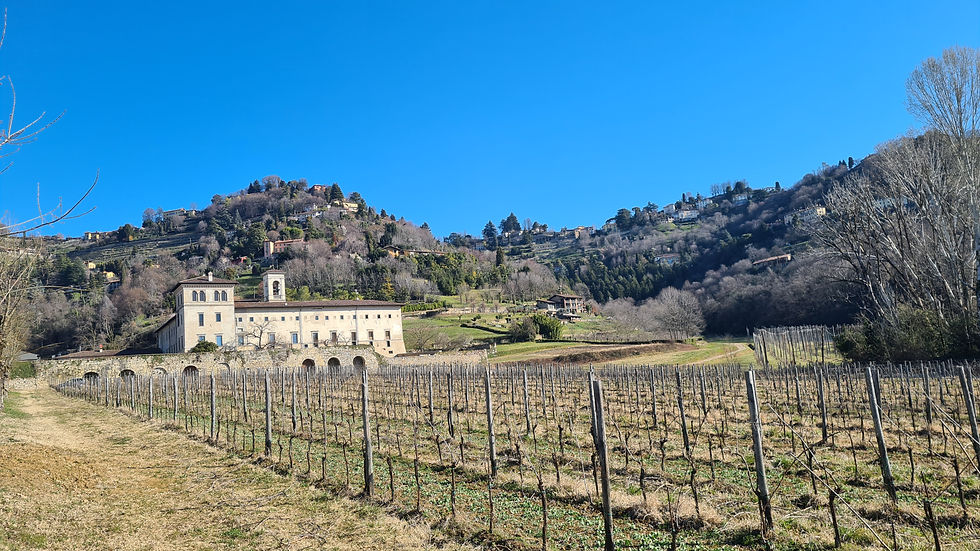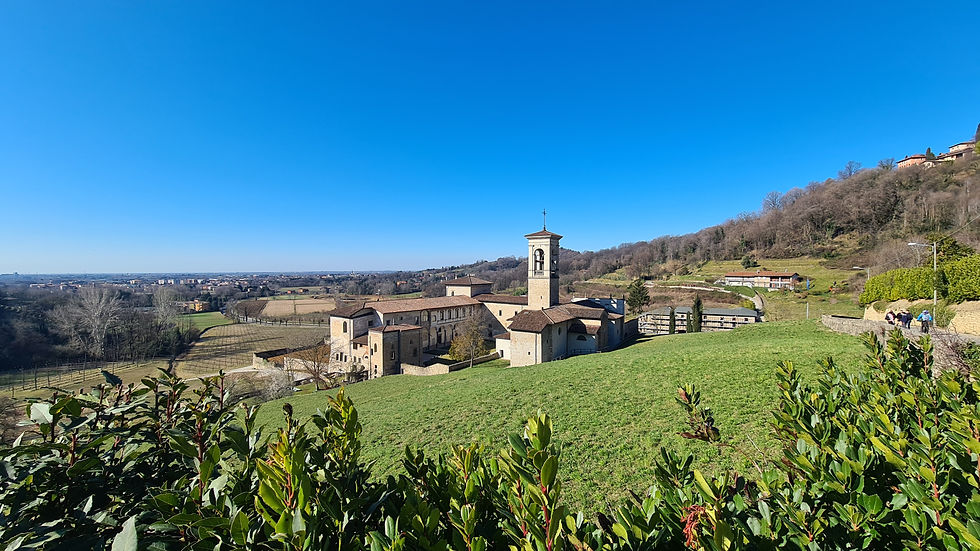Our B&B is in a family house built by Ferdinando Fenili in the most historic part of the Longuelo district, close to the Bergamo hills, where there were once agricultural fields and a few houses and the Astino Valley was still unknown to most of the people.
But now it is all about biodiversity within the city and so the Astino Valley has received the "Landscape Award 2021", awarded by the Council of Europe. The award is given every two years and is aimed at all entities that implement landscape management policies in order to serve as a model for all European countries. The Astino Valley is a place that has been reborn in the name of biodiversity, combining the history of a thousand-year-old monastery, art, tradition, and a typically agricultural environment in the heart of the city. With the project "Biodiversity within the city", it has already received the prestigious “Premio Nazionale del Paesaggio” (“National Landscape Award”) 2021.
Stendhal was in love with Bergamo and its landscape. He described the woods on the hills behind the city as enchanting and the most beautiful he had ever seen. How can we blame him when we're in the middle of the Parco dei Colli di Bergamo, a nearly 5000-hectare protected natural landscape filled with chestnut woods, olive groves, ancient villages, and vineyards.
The Astino Valley is the city's green lung, located near the Allegrezza wood and bordered to the east by the Colle della Benaglia spur, to the north by San Sebastiano and the Colli della Bastia and San Vigilio, and to the west by the Colle dominated by the Villa Bagnada and the Presati Castle. A quiet and peaceful location from which various pedestrian and cycle paths start for excursions along a dense network of streets that run around the monastery. Starting from here, you can walk east to the Longuelo district, west to the San Martino valley and north to San Sebastiano and the hills of Bastia and San Vigilio; you can also easily reach the historic center of Bergamo, Città Alta (Upper Town).

The "Lorenzo Rota" Botanical Garden and the Biodiversity Valley
"The Valley of Biodiversity" is a green space exclusively dedicated to organic farming and is located right in the Astino Valley: it is a section of the "Lorenzo Rota" Botanical Garden which is located in Colle Aperto, in the Upper Town.
A space for learning about sustainability and the interdependence between man, agriculture, and nature. There are 300 species and over 1500 sorts of plantations and crops on 9000 square meters of extension and exposure. They vary according to the season: rustic, tropical, potted, such as tomatoes, corn, cereals, rice, salads, beets, wheats, potatoes, beans and many others. A rich heritage that depicts the story of the crops most commonly used by human beings throughout history, and from May to October visitors can take a walk inside to learn about agricultural biodiversity and/or biodiversity in general.
A laboratory to preserve the plant heritage and convey these testimonies of the entire territory to the public (local and worldwide) and make the nature that surrounds us known. At the entrance to the Botanical Garden, a paper map is available in several languages: Italian, English and German. Through the Smile Visit app you can access interactive content and lots of information on the Biodiversity Valley and the Astino Valley's trails.
The monastery of Astino
The undisputed protagonist of this place is the Monastery of Astino with the adjoining Church of the Holy Sepulcher.
The origin of this place dates back to 1107 when the Vallombrosan monks (from the monastic order of Vallombrosa, near Florence) built the monastery and the Church of the Holy Sepulcher. These are the years in which Bergamo declared itself a free and reformed municipality for the Church, which led to the acceptance of the monks.
The Vallombrosan monks chose the Valle d'Astino as a permanent place to stop at, because it represented the ideal location for their devotion to the Benedictine rule "ora et labora": a perfect quiet place where they could pray and work the land in order to be able to meet all their vital needs. The monastery experienced centuries of growth and expansion, comparable to a glimpse of paradise where time seemed to pass more slowly, due precisely to the monks' rhythm of life. The complex political events that struck Bergamo in the fifteenth century contributed to a first decay of the monk’s community, until the order of monks was suppressed by Napoleon’s regime in 1797.
During the nineteenth century, the monastery served as a psychiatric hospital for poor people and in the first decades of the twentieth century it was destined for agricultural use, only to be sold to private individuals, abandoned and not cared for until 2007. It is the year in which the entire complex was purchased by the Congregation of the Misericordia Maggiore of Bergamo, kicking off important restoration and recovery works of frescoes and works of art hidden by thick layers of white plaster applied inside the monastery between the nineteenth and twentieth centuries. Since this purchase, the monastery and the surrounding areas have become - and continue to be - cultural sites, hosting local events linked to the territory.
During EXPO 2015 in Milan, the monastery was the stage of a variety of food, wine, and nutrition-related activities, exhibitions, and initiatives.

The Church of the Holy Sepulcher and the Last Supper by Allori
Next to the Monastery of Astino stands the Church of the Holy Sepulcher. It is characterized by a particular tau cross with a single nave plan that ends in the transept and has three altars: the main one in a slightly elevated position, the altar of San Martino and the third one dedicated to the Evangelists. In the 16th century it was renovated and refurbished, completing the east wing, the rooms of the south wing and giving life to the south-west corner tower.
In 1580 Calisto Solari, the Abbot of Astino, commissioned Alessandro Allori to create a replica of "The Last Supper" to decorate the refectory room, where the monks ate their meals while listening to the verses of the Bible. Allori, also known as Bronzino, is a leading Florentine artist of the time, a skilled painter who had previously worked in the decoration of Vallombrosan convents and who contributed to the creation of tapestries for the Basilica of Santa Maria Maggiore in Bergamo’s Upper Town.
The canvas is densely packed with still-life symbols; in fact, every flower, food, fruit, or vegetable depicted has a hidden meaning related to the Eucharistic sacrifice and the Passion of Christ.
Today, the work can be seen in its original location, the monastery's refectory, but it has traveled several times: in 1798 it was removed and confiscated as part of the Napoleonic regime's suppression of the convent, then returned to Bergamo, staying for a long time in the Palazzo della Ragione, then in the rooms of the Municipality of Bergamo and finally exhibited in the halls of the Angelo Mai Library.
The Allegrezza wood: find the ancient castle
It is worthwhile to venture beyond the Monastery and the Garden and onto Via Allegrezza. Along the Sella della Madonna del Bosco, a simple path suitable for everybody, you will find yourself in a natural oasis of oaks on the little hill opposite the Madonna del Bosco all the way to the border with Valbrembo.
A few steps from the beginning of the path, there are the ruins of a farmhouse, which is all that remains of the Allegrezza Tower or Castle, an ancient fortress that once belonged to the noble Suardi family in the Middle Ages. Later, with the conquest of Venice and the political stability in Bergamo, the Allegrezza Castle, like other defensive buildings, was converted into a farmhouse and home to the peasants who worked for the monks. The Congregation of the Misericordia Maggiore of Bergamo owns it today.
Now all you have to do is come and visit us to spend a day surrounded by nature and history, just a stone's throw from the city. Our Astino Valley is far too beautiful to be reduced to a simple reading. We can’t wait to meet you and recommend the best itineraries to walk from our B&B and discover enchanting places!
Comments